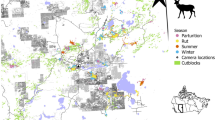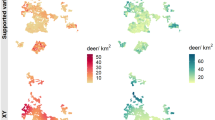Abstract
We used satellite land cover data and the program FRAGSTATS toquantify land cover types and calculate the amount of forest edge available in suburban and rural regions of northeastern and northwestern Massachusetts. Cover categories included forest cover, open canopy vegetation, and non-deer habitat. We calculated all edge segments where forest cover abutted open canopy cover. Our open canopy vegetation category was calculated both with and without low intensity suburban development. We then compared these findings to movement data from 53 (13 males, 40 females) adult radio-marked white-tailed deerOdocoileus virginianusmonitored biweekly and diurnally from January 2001 to January 2003. The range of movements of suburban deer in eastern Massachusetts showed no difference to that of suburban deer in western Massachusetts (P = 0.7). However, the ranges for suburban deer in both eastern and western Massachusetts were 10 times less than those of deer in rural western Massachusetts (P = 0.001).Our findings suggest that landscape configuration, as described by the amount and distribution of edge due to suburban development, which is related to the amount and distribution of resources such as food and cover, affects migratory behavior of white-tailed deer, allowsdeer to have smaller ranges, and contributes to high deer densities.Inclusion of suburban edge in habitat models will increase our understanding of deer-habitat relationships for management of deer in urbanizing environments.
Similar content being viewed by others
References
Alverson, W.S., Waller, D.M. and Solheim, S.L. (1988) Forests too deer: Edge effects in northern Wisconsin. Conserv. Biol. 2, 348–358.
Danielson, W.R., DeGraaf, R.M. and Fuller, T.K. (1997) Rural and suburban forest edges: Effect of egg predators on nest predation rates. Landscape and Urban Planning 38, 25–36.
DeGraaf, R.M., Yamasaki, M., Leak, W.B. and Lanier, J.W. (1989) New England wildlife: Management of forested habitats. Northeastern Forest Experiment Station General Technical Report NE-144, Amherst, MA.
DeStefano, S. and DeGraaf, R.M. (2003) Exploring the ecology of suburban wildlife. Frontiers in Ecol. and the Environ. 1, 95–101.
Dickman, C.R. (1987) Habitat fragmentation and vertebrate species richness in an urban environment. J. Applied Ecol. 24, 337–351.
Garshelis, D.L. (2000) Delusions in habitat evaluation. In Research techniques in Animal Ecology (L. Boitani and T.K. Fuller, eds.), pp. 111–164. Colombia Univ. Press, New York, NY.
Kenward, R.E. (2001) A Manual for Wildlife Radio Tagging. Academic Press, Inc., London, UK.
Kilpatrick, H.J. and Spohr, S.M. (2000) Movements of female white-tailed deer in a suburban landscape: a management perspective. Wildl. Soc. Bull. 28, 1038–1045.
Leopold, A. (1933) Game Management.University of Wisconsin Press, Madison.
Marzluff, J.M., McGowan, K.J., Donnelly, R. and Knight, R.L. (2001) Causes and consequences of expanding American crow populations. In Avian Ecology and Conservation in an Urbanizing World (J.M. Marzluff, R. Bowman and R. Donnelly, eds.), pp. 331–363. Kluwer Academic Publ., Boston, MA.
McCullough, D.R. (1984) Lessons from the George Reserve Michigan. In White-Tailed Deer: Ecology and Management (L.K. Halls, ed.), pp. 211–242. Stackpole Publ., Harrisburg, PA.
McGarigal, K. and Marks, B.J. (1995) FRAGSTATS: Spatial Pattern Analysis Program for Quantifying Landscape Structure.USDA Forest Service General Technical Report PNW-351.
McGowan, K.J. (2001) Demographic and behavioral comparisons of suburban and rural American crows. In Avian Ecology and Conservation in an Urbanizing World. (J.M. Marzluff, R. Bowman and R. Donnelly, eds.), pp. 365–381. Kluwer Academic Publ., Boston, MA.
Mendenhall, W., Beaver, R.J. and Beaver, B.M. (1999) Introduction to Probability and Statistics.Duxbury Press, Pacific Grove, CA.
Multi-Resolution Land Characterization Consortium (MRLC). (2000) National land cover data, http://www.epa.gov/mrlc/nlcd.html (16 March 2000).
Nelson, M.E. (1995) Winter range arrival and departure of white-tailed deer in northeastern Minnesota. Canadian J. Zool. 73, 1069–1076.
NOAA. (2005) National Operational Hydrological Remote Sensing Center. http://www.nohrsc.noaa.gov/nsa/ (21 April 2005).
Peragallo, T.A. (1989) Soil Survey of Norfolk and Suffolk Counties, Massachusetts. USDA-Soil Conservation Service, United States Department of Agriculture.
Sabine, D.L., Morrison, S.F., Whitlaw, H.A., Ballard, W.B., Forbes, G.J. and Bowman, J. (2002) Migration behavior of white-tailed deer under varying winter climate regimes in New Brunswick. J. Wildl. Manage. 66, 718–728.
Samuel, M.D. and Fuller, M.R. (1994) Wildlife radiotelemetry. In Research and Management Techniques for Wildlife and Habitats, Fifth edition (T.A. Bookhout, ed.), pp. 370–418. The Wildlife Society, Bethesda, MD.
Scanu, R.J. (1988) Soil Survey of Berkshire County Massachusetts.USDA-Soil Conservation Service, United States Department of Agriculture.
Steel, J. (1999) Losing Ground: An Analysis of Recent Rates and Patterns of Development and Their Effects on Open Space in Massachusetts. Masachusetts Audubon Society, Lincoln, MA.
Tierson, W.C., Mattfield, G.F., Sage, R.W., Jr. and Behrend, D.E. (1985) Seasonal movements and home range of white-tailed deer in the Adirondacks. J. Wildl. Manage. 49, 760–769.
Van Deelen, T.R., Campa, H., Hamady, M. and Haufler, J.B. (1998) Migration and seasonal range dynamics of deer using adjacent deeryards in northern Michigan. J. Wildl. Manage. 62, 205–213.
Verme, L.J. (1973) Movements of white-tailed deer in upper Michigan. J. Wildl. Manage. 37, 545–552.
Vogelman, J.E. (1995) Assessment of forest fragmentation in southern New England using remote sensing and geographic information systems technology. Conserv. Biol. 9, 439–449.
White, G.C. and Garrot, R.A. (1990) Analysis of Wildlife Radio-Tracking Data. Academic Press, San Diego, CA.
Yahner, R.H. (1988) Changes in wildlife communities near edges. Conserv. Biol. 2, 333.
Author information
Authors and Affiliations
Corresponding author
Additional information
An erratum to this article is available at http://dx.doi.org/10.1007/s11252-006-9987-1.
Rights and permissions
About this article
Cite this article
Gaughan, C.R., Destefano, S. Collaboration for community-based wildlife management. Urban Ecosyst 8, 191–202 (2005). https://doi.org/10.1007/s11252-005-3265-5
Issue Date:
DOI: https://doi.org/10.1007/s11252-005-3265-5




